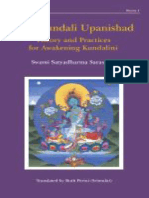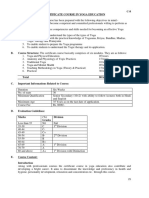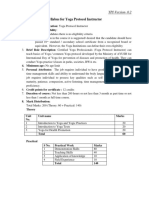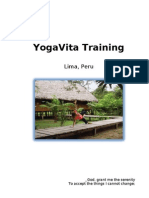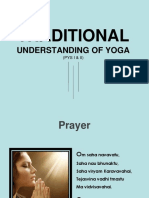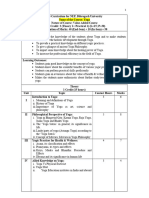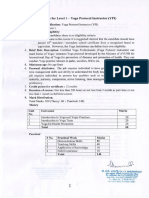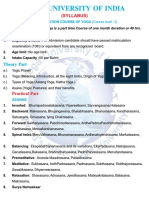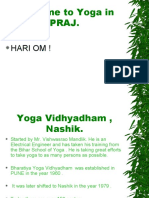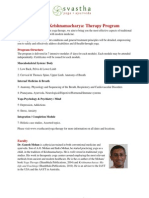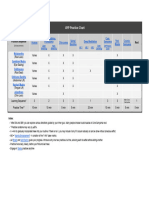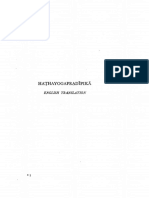Syllabus Introductory
Syllabus Introductory
Uploaded by
learningmaterialondrive2Copyright:
Available Formats
Syllabus Introductory
Syllabus Introductory
Uploaded by
learningmaterialondrive2Copyright
Available Formats
Share this document
Did you find this document useful?
Is this content inappropriate?
Copyright:
Available Formats
Syllabus Introductory
Syllabus Introductory
Uploaded by
learningmaterialondrive2Copyright:
Available Formats
IYFDK 2017 Syllabus Introductory Level Page 1 of 4
Syllabus for Introductory I
Introductory I & II levels are assessed together. Candidates will be responsible for all of the information
in both syllabuses. The written exam covers material on both the Introductory I and II reading lists.
Reading
1. Introduction to Light on Yoga
2. Part one, Section I of Light on Pranayama
3. Yoga in Action, Preliminary Course
4. Yoga in Action, Intermediate Course
5. Part II The leaves and Part Four Pranayama in The Tree of Yoga
6. Sutras II.29 – II.48 in Light on the yoga Sutras of Patanjali
7. What is written about every asana and its stages and pranayama on this syllabus in Yoga in Action,
Preliminary Course and Yoga in Action, Intermediate Course
8. What is written about every asana and pranayama on this syllabus in Light on Yoga.
9. What is written about every asana and pranayama on this syllabus in Yoga, a Gem for Women.
10. Part II Asana: hints and Cautions for the practice of asanas and Part III: Pranayama hints and
Cautions in Light on Yoga.
11. What is written about every asana and pranayama on this syllabus in Light on Pranayama.
12. Section II Chapter 10 Hints and Caution in Light on Pranayama.
13. Chapter X Part I General Hints of Yoga, a Gem for Women.
14. Yoga, A Gem for Women, Chapter I-VI; Chapter VII, 1. Menstruation; Chapter VIII, the description of
the systems.
15. Basic Guidelines for Teachers of Yoga (January 2003 revised edition) by B.K.S. Iyengar and Geeta S.
Iyengar. Read the entire book but concentrate on Chapter I; Chapter II pp.21-24; Chapters III, IV and
V; Chapter VI pp 70-74, 76(#13 and #14), pp 88-89(#18-23); Chapter VIII pp.110-111 - The systems,
pp.115-117 - Skeletal and Muscular Systems, and Chapter IX for sample questions and answers that
relate to your syllabus.
16. Any basic anatomy book
Required Knowledge
1. Practical knowledge about the asanas and their stages and pranayamas on your syllabus
2. What is the definition of yoga
3. Names and definitions of the four padas of Patanjala yoga Sutra
4. Names in Sanskrit and definitions of the eight limbs of astanga yoga
5. Names in Sanskrit and definitions of the yamas and niyamas
6. How to construct a sequence for a beginner’s class
7. How to modify the asanas on your syllabus for complaints of neck or shoulder pain, sore knees, backs,
or hips, as given in Yoga, A Gem for Women
8. An appropriate sequence for menstruation
9. The following anatomy:
a. Name and define the major systems of the body
b. The name, shape, and location of each of the major bones of the body
c. Major superficial muscles of the body
Iyengar Yoga Foreningen Danmark, CVR nr. /Reg. No: 37285633
www.iyengaryogaorg.dk – iyfdkk@gmail.com
IYFDK 2017 Syllabus Introductory Level Page 2 of 4
Asanas for Introductory I
Asana in boldface are especially likely to be tested at any higher assessment level.
1. Tadasana
2. Vrksasana
3. Utthita Trikonasana
4. Virabhadrasana II
5. Utthita Parsvakonasana
6. Virabhadrasana I
7. Ardha Chandrasana
8. Parsvottanasana (arms down-concave and convex)
9. Prasarita Padottanasana (concave back; see Light on Yoga, plate 31)
10. Parighasana
11. Padangusthasana (concave and downward extending spine)
12. Padahastasana (concave and downward extending spine)
13. Uttanasana (concave back)
14. Adho Mukha Svanasana (with support)
15. Utkatasana
16. Dandasana
17. Gomukhasana (arms only)
18. Siddhasana
19. Virasana
20. Parvatasana in Svastikasana
21. Triang Mukhaikapada Paschimottanasana
22. Marichyasana I (twist only, see Light on Yoga plate 143)
23. Malasana (a) with wall support for sacrum; arms extended parallel to floor; (b) away from wall, heels
on rolled blanket, arms extended parallel to floor, knees together; (see Light on Yoga, plate 317)
24. Salamba Sarvangasana I
25. Halasana (feet on stool)
26. Karnapidasana
27. Supta Konasana
28. Chatushpadasana (see Light on Yoga, plate 258; Yoga, a Gem for Women, plate 102. This asana is
similar in form to Setubandha Sarvangasana, with the hands holding the ankles.)
29. Setubandha Sarvangasana (sacrum supported on a block)
30. Urdhva Prasarita Padasana (90°)
31. Bharadvajasana I (turning, without holding the upper arm)
32. Savasana (on bolster with eyes covered, observing the normal in breath and out breath)
Pranayamas for Introductory I (Refer to Light on Pranayama)
1. Ujjayi I - II
2. Viloma I and II
Iyengar Yoga Foreningen Danmark, CVR nr. /Reg. No: 37285633
www.iyengaryogaorg.dk – iyfdkk@gmail.com
IYFDK 2017 Syllabus Introductory Level Page 3 of 4
Syllabus for Introductory II
(includes responsibility for Introductory I Syllabus)
Includes responsibility for all previous syllabi. Questions on the Written Exam will be drawn from the
material on both the Introductory I & II reading list.
Reading
1. Introduction to Light on the Yoga Sutras of Patanjali
2. Sutras II.49 – III.13 in Light on the Yoga Sutras of Patanjali
3. What is written about every asana and its stages and pranayama on this and the previous syllabus in
Yoga in Action, Preliminary Course and Yoga in Action: An Intermediate Course
4. What is written about every asana and pranayama on this and the previous syllabus in Light on Yoga.
5. What is written about every asana and pranayama on this and the previous syllabus in Yoga, a Gem for
Women
6. What is written about every asana and pranayama on this and the previous syllabus in Light on
Pranayama.
7. Basic Guidelines for Teacher of Yoga (January 2003 revised edition) by B.K.S. Iyengar and Geeta S.
Iyengar. Read the entire book but concentrate on Chapter I; Chapter II pp. 21-24; Chapter III; Chapter
VI pp. 70-73, p.75 (#4-5) pp. 89-93; Chapter VIII pp.105-6; and Chapter IX for sample questions
and answers that relate to your syllabus.
8. Yoga, A Gem for Women, Chapter III Patanjali’s Definition through Antaratma Sadhana; then asana
through Samadhi.
9. Any basic anatomy book
Required Knowledge
1. Required knowledge from previous syllabus
2. Practical knowledge about the asanas and their stages and pranayamas on your syllabi
3. Know the basic information given on the last 5 limbs of astanga yoga in Light on the Yoga Sutras of
Patanjali and in any of your other readings.
4. Understanding of the following concepts:
a) citta
b) sadhana
c) prana
d) abhyasa and vairagya
e) purusa and prakrti
f) samyama
g) parinama
5. Sanskrit name and definition of each of the gunas
6. Pranayama: philosophical basis, components, hints and cautions
7. The following anatomy:
a) The differences between muscles, ligaments and tendons.
b) The structure and type of movement of the major joints of the body.
8. Definition of the following terms and how they apply to the movement of joints of the body:
a) flexion
b) extension
c) abduction
d) adduction
e) rotation
f) circumduction
g) pronation
h) supination
i) dorsiflexion
j) plantar flexion
k) eversion
l) inversion
9. Main joint movements in the asanas on your syllabus
Iyengar Yoga Foreningen Danmark, CVR nr. /Reg. No: 37285633
www.iyengaryogaorg.dk – iyfdkk@gmail.com
IYFDK 2017 Syllabus Introductory Level Page 4 of 4
Asanas for Introductory II
Candidates will be asked to demonstrate asana from both this and the previous syllabi. Asana in bold-face
are especially likely to be tested at any higher assessment level.
1. Garudasana
2. Parivrtta Trikonasana
3. Parivrtta Parsvakonasana
4. Parivrtta Ardha Chandrasana (see Art of Yoga, plate 13)
5. Virabhadrasana III
6. Utthita Hasta Padangusthasana I (leg to the front, with and without support)
7. Adho Mukha Svanasana (with support)
8. Parsvottanasana (classic asana)
9. Prasarita Padottanasana I (classic asana)
10. Uttanasana (classic asana)
11. Urdhva Mukha Svanasana
12. Chaturanga Dandasana
13. Bhujangasana I
14. Dhanurasana
15. Salabasana
16. Makarasana
17. Ustrasana
18. Paripurna Navasana
19. Ardha Navasana
20. Supta Virasana (supported and not supported)
21. Baddha Konasana (sitting straight; give margin if difficult)
22. Supta Baddha Konasana
23. Upavistha Konasana (sitting straight)
24. Janu Sirsasana
25. Marichyasana I (Plate 144)
26. Paschimottanasana (also called Ugrasana or Brahmacharyasana)
27. Salamba Sirsasana (against wall; know how to teach with ropes, when available)
28. Salamba Sarvangasana I
29. Halasana (toes on floor, plate 240)
30. Eka Pada Sarvangasana
31. Parsvaika Pada Sarvangasana (as far as possible)
32. Parsva Halasana
33. Setu Bandha Sarvangasana (also called Uttana Mayurasana) (from Sarvangasana, with bent
knees, feet dropping to wall, block, or chair)
34. Supta Padangusthasana I and II (First stage and lateral stage, see Light on Yoga plate 284 and 287)
35. Bharadvajasana I (classic asana)
36. Bharadvajasana II
37. Malasana (heels down, can grasp wall hooks or other available support; see Light on Yoga, plate 317)
38. Marichyasana III (opposite bent elbow over the bent knee; see Light on Yoga, plate 301)
39. Ardha Matsyendrasana I (with support, e.g., folded blanket between buttock and foot; against wall;
see Light on Yoga, plates 307-308)
40. Urdhva Dhanurasana I (supported on chair, with hands and feet on floor or blocks; knees bent;
pushing up if possible)
41. Dwi Pada Viparita Dandasana (on a chair; legs parallel to floor; holding back legs of chair)
42. Savasana (with eye band; normal in breath and deep out breath)
Pranayamas for Introductory II (Refer to Light on Pranayama)
1. Ujjayi III and IV
2. Viloma III
3. Bhramari Ia, IB, IIa, and II B
Iyengar Yoga Foreningen Danmark, CVR nr. /Reg. No: 37285633
www.iyengaryogaorg.dk – iyfdkk@gmail.com
You might also like
- Dhirendra Brahmachari - Yogasana VijnanaDocument390 pagesDhirendra Brahmachari - Yogasana VijnanaKulin ShahNo ratings yet
- YIC Part 2Document186 pagesYIC Part 2Gowtham MS100% (3)
- The Yoga Beginner's Bible: Top 63 Illustrated Poses for Weight Loss, Stress Relief and Inner PeaceFrom EverandThe Yoga Beginner's Bible: Top 63 Illustrated Poses for Weight Loss, Stress Relief and Inner PeaceRating: 4 out of 5 stars4/5 (5)
- FINAL M.SC (YT) Hatha Yoga Pradipika - MCQ - QuestionsDocument39 pagesFINAL M.SC (YT) Hatha Yoga Pradipika - MCQ - QuestionsWisdom Talks100% (13)
- Yoga Kundali UpanishadDocument160 pagesYoga Kundali UpanishadTranscendent Siba100% (8)
- Yoga English Medium MCQ PDFDocument67 pagesYoga English Medium MCQ PDFAnsh mishra100% (1)
- Iyengar YogaDocument38 pagesIyengar YogaYoga Avec Nathalie100% (4)
- Krishnamacharya's Practice Guidelines: Yoga Makaranda (1934) Yoga Makaranda (Part II) Yogasanagalu (1941)Document52 pagesKrishnamacharya's Practice Guidelines: Yoga Makaranda (1934) Yoga Makaranda (Part II) Yogasanagalu (1941)rashid_1806100% (1)
- Krishnamacharya's Yoaga Asana Practice GuidelinesDocument52 pagesKrishnamacharya's Yoaga Asana Practice GuidelinesAnthony Grim Hall100% (11)
- Iyengar Self PracticeDocument12 pagesIyengar Self PracticeJoesmow100% (5)
- YCB Level-1: 1 Introduction To Yoga and Yogic Practices 2 Introduction To Yoga TextsDocument20 pagesYCB Level-1: 1 Introduction To Yoga and Yogic Practices 2 Introduction To Yoga TextsGeeta JiraliNo ratings yet
- The Kriya Yoga PracticesDocument11 pagesThe Kriya Yoga PracticesTushar Naik100% (48)
- Strategic Sorcery Lesson 1 - Meditation Part 1Document11 pagesStrategic Sorcery Lesson 1 - Meditation Part 1fatuo334467% (9)
- Syllabus Intermediate Junior IIDocument2 pagesSyllabus Intermediate Junior IICarmen OrniaNo ratings yet
- Iyengar Yoga UK SyllabusDocument13 pagesIyengar Yoga UK SyllabusSummit Gautam100% (1)
- Yoga Makaranda Part 2 Sri T KrishnamacharyaDocument138 pagesYoga Makaranda Part 2 Sri T KrishnamacharyaintenselightNo ratings yet
- Rajendra YogaDocument228 pagesRajendra YogaElena ColesnicovaNo ratings yet
- PE 10 Q2 M7-ModifiedDocument14 pagesPE 10 Q2 M7-ModifiedJubilo , Daniella Mae S.No ratings yet
- 21 Yo 83Document5 pages21 Yo 83lxl.reshma.lxlNo ratings yet
- Yoga Teacher Training Curriculum & Program - Himalayan Yoga Academy (Rishikesh, India) - 2012-13Document9 pagesYoga Teacher Training Curriculum & Program - Himalayan Yoga Academy (Rishikesh, India) - 2012-13Anastasia Kurdina0% (2)
- Yogasanagalu (Translation Project)Document74 pagesYogasanagalu (Translation Project)Bhairava Sanjay NathaNo ratings yet
- Syllabus YWI Version0.2 PDFDocument8 pagesSyllabus YWI Version0.2 PDFJayakumar nadesan vasanthaNo ratings yet
- AcknowledgementDocument17 pagesAcknowledgementravikumar707No ratings yet
- Basic Course-YogaDocument3 pagesBasic Course-Yogabalmukundsinghbisen15122001No ratings yet
- Syllabus For Level 2Document8 pagesSyllabus For Level 2Vedic Yog PeethNo ratings yet
- Syllabus For Yoga Protocol InstructorDocument6 pagesSyllabus For Yoga Protocol InstructorAditya DasNo ratings yet
- Syllabus YPI Version0.2Document6 pagesSyllabus YPI Version0.2Ojasvini SharmaNo ratings yet
- Study On The Effect of Yoga On Resting Cardiovascular Parameters and Cardiovascular Autonomic FunctionsDocument5 pagesStudy On The Effect of Yoga On Resting Cardiovascular Parameters and Cardiovascular Autonomic FunctionsEditor IJTSRDNo ratings yet
- QCI Syllabus For Level 1Document6 pagesQCI Syllabus For Level 1Vedic Yog PeethNo ratings yet
- Yoga Basics: The Basic Poses and Routines you Need to be Healthy and RelaxedFrom EverandYoga Basics: The Basic Poses and Routines you Need to be Healthy and RelaxedNo ratings yet
- Introduction To Yoga Reprt Lavit Saini 21BCON617Document18 pagesIntroduction To Yoga Reprt Lavit Saini 21BCON617Lavit SainiNo ratings yet
- Ccywi YogasanaDocument5 pagesCcywi YogasanaJuhi MittalNo ratings yet
- YogaVita TrainingDocument102 pagesYogaVita TrainingYovita Ivanova100% (1)
- Yoga ThesisDocument9 pagesYoga Thesishptfbggig100% (1)
- 1st Lecure-Yoga On 1 Jan 2024 - 0.1Document9 pages1st Lecure-Yoga On 1 Jan 2024 - 0.1aartiNo ratings yet
- Yoga is also a sport in Physical EdDocument2 pagesYoga is also a sport in Physical EdShlok KhareNo ratings yet
- The Power of Ashtanga Yoga II: A Practice to Open Your Heart and Purify Your Body and MindFrom EverandThe Power of Ashtanga Yoga II: A Practice to Open Your Heart and Purify Your Body and MindNo ratings yet
- Yoga Is Also A Sport in Physical EducationDocument4 pagesYoga Is Also A Sport in Physical EducationVishesh TyagiNo ratings yet
- YTTP-Theory Book 495-497-33-48Document16 pagesYTTP-Theory Book 495-497-33-48NALINI RAGHAVNo ratings yet
- Yoga ProjDocument11 pagesYoga Projatharvamalviya4No ratings yet
- Yoga PdfDocument119 pagesYoga Pdfparasharsoumya339No ratings yet
- 2c - Traditional Yoga PDFDocument45 pages2c - Traditional Yoga PDFparvesh sangwan100% (1)
- 1st Lecure-Yoga On 13th Jan 2024Document15 pages1st Lecure-Yoga On 13th Jan 2024aartiNo ratings yet
- Props For Yoga Volume III in Eyal ShifroniDocument237 pagesProps For Yoga Volume III in Eyal ShifroniIstvánZsigóNo ratings yet
- VAC 4 YogaDocument2 pagesVAC 4 YogaKrishna PrajapatiNo ratings yet
- Eight Stepped AsanasDocument20 pagesEight Stepped Asanasvkrishnal902No ratings yet
- Syllabus Level 1 PDFDocument6 pagesSyllabus Level 1 PDFSwaprakash RoyNo ratings yet
- SyllabusDocument21 pagesSyllabusTricky soccerNo ratings yet
- Yoga Project 12 VaishaliDocument14 pagesYoga Project 12 Vaishalibhavintaviyad02100% (1)
- Dr. Jyoti Gangwal 2020Document7 pagesDr. Jyoti Gangwal 2020Support CocNo ratings yet
- Advanced Hatha Yoga: Classic Methods of Physical Education and ConcentrationFrom EverandAdvanced Hatha Yoga: Classic Methods of Physical Education and ConcentrationRating: 5 out of 5 stars5/5 (1)
- Yoga and Pranayama During High-Risk PregnancyDocument7 pagesYoga and Pranayama During High-Risk PregnancyAdvanced Research PublicationsNo ratings yet
- 1 - Syllebus of Yoga CoursesDocument11 pages1 - Syllebus of Yoga CoursesJilla VishwasNo ratings yet
- Welcome To Yoga in Praj.: Hari Om !Document16 pagesWelcome To Yoga in Praj.: Hari Om !pawanishanNo ratings yet
- Svastha Yoga of Krishnamacharya: Therapy ProgramDocument7 pagesSvastha Yoga of Krishnamacharya: Therapy ProgramUwe HeimNo ratings yet
- Syllabus For Level 1 - Yoga Protocol Instructor (YPI)Document5 pagesSyllabus For Level 1 - Yoga Protocol Instructor (YPI)puNo ratings yet
- The Use of Props For Theraputic Purposes in Iyengar YogaDocument8 pagesThe Use of Props For Theraputic Purposes in Iyengar Yogazooris100% (1)
- Ashtanga Yoga As Everyday PracticeDocument17 pagesAshtanga Yoga As Everyday Practiceapi-3750171100% (1)
- History of YogaDocument8 pagesHistory of YogaShubham NaleNo ratings yet
- Class NotesDocument9 pagesClass Notesmemespace03No ratings yet
- Easy Yoga Your Ultimate BeginnersDocument68 pagesEasy Yoga Your Ultimate Beginnersinspire.yoga003No ratings yet
- Handbook On Yoga 09jun16Document80 pagesHandbook On Yoga 09jun16divakarNo ratings yet
- Monday Yoga: Pranayam and Sukshma-Asana's for starting Your Routine Yoga Practice and Inducing Vigor into Your Life on the first day of the WeekFrom EverandMonday Yoga: Pranayam and Sukshma-Asana's for starting Your Routine Yoga Practice and Inducing Vigor into Your Life on the first day of the WeekNo ratings yet
- Yoga For Beginners: Iyengar Yoga: The Complete Guide to Master Iyengar Yoga; Benefits, Essentials, Asanas (with Pictures), Pranayamas, Meditation, Safety Tips, Common Mistakes, FAQs, and Common MythsFrom EverandYoga For Beginners: Iyengar Yoga: The Complete Guide to Master Iyengar Yoga; Benefits, Essentials, Asanas (with Pictures), Pranayamas, Meditation, Safety Tips, Common Mistakes, FAQs, and Common MythsNo ratings yet
- Brahma Shakti Vinyasa Yoga. A sustainable practice for life. Born from AshtangaFrom EverandBrahma Shakti Vinyasa Yoga. A sustainable practice for life. Born from AshtangaNo ratings yet
- The Nuts and Bolts of Teaching a Yoga ClassFrom EverandThe Nuts and Bolts of Teaching a Yoga ClassRating: 5 out of 5 stars5/5 (4)
- ENG NOTES YOGA Philosophy and Practice 3rd Sem-1Document48 pagesENG NOTES YOGA Philosophy and Practice 3rd Sem-1k31719686No ratings yet
- List of Asanas - WikipediaDocument11 pagesList of Asanas - WikipediaVarun ChaudhariNo ratings yet
- Sitting Poses in Yoga and PranayamaDocument4 pagesSitting Poses in Yoga and PranayamaLaerte100% (1)
- SIDDHASANADocument3 pagesSIDDHASANAShubham SehrawatNo ratings yet
- Hatha Yoga Pradipika - MuktibodhanandaDocument655 pagesHatha Yoga Pradipika - MuktibodhanandamislhanumanwaliaNo ratings yet
- अपरोक्षानुभूति aparokṣānubhūti 111 to 120 lessonsDocument12 pagesअपरोक्षानुभूति aparokṣānubhūti 111 to 120 lessonsgmurthyNo ratings yet
- Hatha Yoga TextsDocument28 pagesHatha Yoga Textssudarsana.yogaarthiNo ratings yet
- Class VII Question BankDocument6 pagesClass VII Question Banksarjisalam98No ratings yet
- Padmasana Siddhasana Simhasana Bhadrasana Swasthikasana Gomukasana VirasanaDocument1 pagePadmasana Siddhasana Simhasana Bhadrasana Swasthikasana Gomukasana VirasanaMadan KumarNo ratings yet
- AsanaDocument20 pagesAsanaRavi KumarNo ratings yet
- Vipul Yoga 2Document38 pagesVipul Yoga 2Vipul MishraNo ratings yet
- Shambavi Maha MudraDocument3 pagesShambavi Maha Mudra8yfwdrhstmNo ratings yet
- Siddhasana PDFDocument2 pagesSiddhasana PDFnithin_v90No ratings yet
- SiddhasanaDocument13 pagesSiddhasanassmaddiNo ratings yet
- Yoga VidyaDocument1 pageYoga Vidyaakk2504No ratings yet
- AsanaDocument7 pagesAsanasanya kundraNo ratings yet
- Hatha Yoga PradipikaDocument24 pagesHatha Yoga PradipikabinpajamaNo ratings yet
- AYP Practice ChartDocument1 pageAYP Practice ChartelantimmonsNo ratings yet
- Siddhasana: Adept's PoseDocument11 pagesSiddhasana: Adept's Posesana shiekhNo ratings yet
- List of Asanas - WikipediaDocument13 pagesList of Asanas - WikipediascribdsNo ratings yet
- Hatha Yoga Pradipika Muktibodhananda - Compressed (101 300) PDFDocument200 pagesHatha Yoga Pradipika Muktibodhananda - Compressed (101 300) PDFHari Krishna100% (1)
- Hatha - Yoga - Pradipika Brahmananda PDFDocument90 pagesHatha - Yoga - Pradipika Brahmananda PDFAlexey PetrovNo ratings yet
- The Secret of Khechari MudraDocument5 pagesThe Secret of Khechari Mudraafag arasNo ratings yet
- Svara YogaDocument57 pagesSvara YogakartikscribdNo ratings yet




